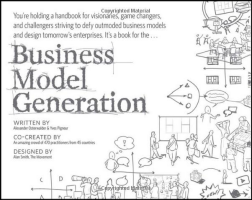|

Business Model Generation is a handbook for visionaries, game changers, and challengers striving
to defy outmoded business models and design tomorrow's enterprises. If your organization needs to
adapt to harsh new realities, but you don't yet have a strategy that will get you out in front of your
competitors, you need
Business Model Generation.
Co-created by 470 business model practitioners from 45 countries, the book features a beautiful,
highly visual, four-color design that takes powerful strategic ideas and tools, and makes them easy
to implement in your organization. It explains the most common Business Model patterns, based on
concepts from leading business thinkers, and helps you reinterpret them for your own context.
You'll learn how to systematically understand, design, and implement a game-changing business model
- or analyze and renovate an old one. Along the way, you'll understand at a much deeper level your
customers, distribution channels, partners, revenue streams, costs, and your core value proposition.

The authors believe a business model can best be described through nine basic building
blocks that show the logic of how a company intends to make money. The nine blocks cover
the four main areas of a business: customers, offers, infrastructure, and financial viability.
The nine business model building blocks form the basis for a handy tool, which we call the
Business Model Canvas. This tool resembles a painter's canvas - performated with
nine blocks - which allows you to paint pictures of new or existing business models.
The Business Model Canvas was designed by Alexander Osterwalder and Yves Pigneur
and is available under the Creative Commons license. It can be downloaded as a PDF file
from Business Model Innovation Hub
The Business Model Canvas can be used to develop a business model or it can be used to gain an
understanding of the strengths and weaknesses of an existing business. Into each box of the model
you can enter a detail of your business model. If you're entering information about an existing business,
you can indicate if this aspect of the business is a strength or weakness.
Reader Michael Uschold says, "This is an absolutely superb book and my first and only book on
business models. It is so up to date and filled with gems that I feel no need to read another anytime soon.
The book is aptly titled, being all about how to generate business models. However, you have to know
what it is before you can generate it. To this end, the first section of the book is devoted to introducing
a standard language and format for talking about business models. They introduce nine key items
which serve as the building blocks for all business models."

Click here for more information.

| 
